
Boozing is an awesome anytime activity in Tokyo. 7-Eleven tallboys and your average bar's draft run hundreds of yen cheaper than a cappuccino, and since trains stop running at midnight, nearly all watering holes remain open and packed until dawn. But to cultivate that Cheers-like vibe, in a joint a tenth of the size but with 10,000 times the character...that takes some effort. I spend my time in Golden Gai, a network of narrow alleys whose collective footprint approximates Tompkins Square Park, yet is filled with some 200 unique, tiny-ass bars.
Where to go? The shockingly pink Love and Peace? The jazz-eclectic Dan-SING-Cinema, up a crippling flight of stairs? (Most of these bars stacked two high.) The geek-chic Bar Plastic Model? Be warned: there will be “seat charges,” either a flat fee or hourly rate to sit your ass down and drink. That's because all these joints have regulars—artists, musicians, writers, whatever—who expect their usual seat (of like eight). Bar-hopping in Golden Gai gets expensive quick.
Luckily, I found my Cheers. It's called Darling.
Japanese splatter film posters (Robogeisha and The Machine Girl anyone?)—most of which feature acting by Darling's charming owner Yūya Ishikawa—blanket the cramped space. If Yūya's in the house, then Group Sounds-era crooner Kenji Sawada will be wafting from the stereo. Otherwise, expect jazz or Motörhead, as cutie bartender Ichiko serves a full spread of the harder stuff. To offset that 800-yen seat charge (and dull the booze), Ichiko adds a complimentary snack. One night I swear it was a mini chalupa, likeOrtega-style—I don't know how she made that in Darling's dollhouse-sized kitchen.
The J-Horror world frequents Darling, plus Eiga Hiho journalists like Yoshiki Takahashi (those extra-splattery posters and “Taxi Driver” sake label? All Yoshiki-designed) and noise musicians. If I'm lucky, Tokyo Dolores pole-dance troupe leader Cay Izumi. If I'm luckier, a handful of Mutant Girls Squad actresses.
Last December was Darling's sixth anniversary, coinciding with Yūya-san's birthday and the evidently rare Japanese lunar eclipse. A crowded night of “飲み放題” (“all-you-can-drink”, truly an awesome concept) and debauchery ensued. I'd been frequenting Darling for over a year then, and I never felt closer to home.
If you end up within Golden Gai, I suggest Nagi—a Fist of the North Star-themed ramen joint—as your pre- or post-drinking nosh spot. Nagi's unctuous, garlicky deliciousness is guaranteed to soak up any alcoholic embers. Plus, any woman willing to get near my post-Nagi breath is A-OK in my book.
Images: overhead shot UnmissableTOKYO.com, all Darling photos courtesy the author
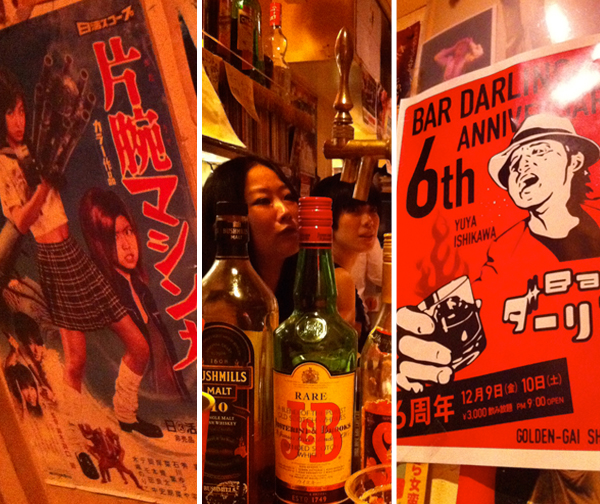
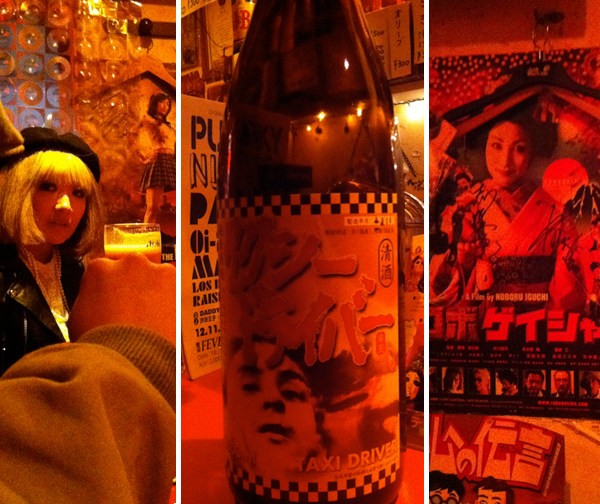
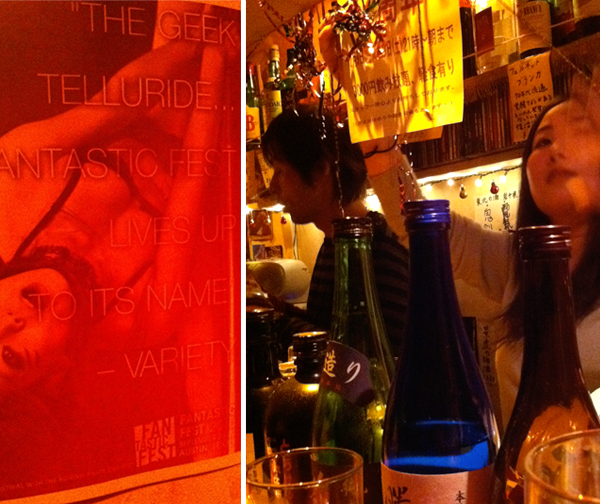
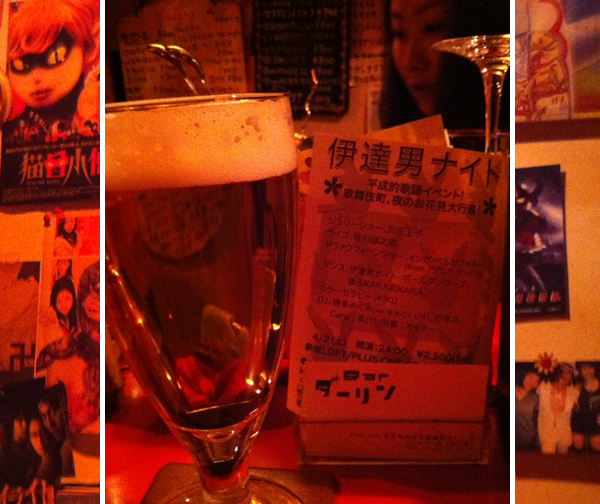

On my recent trip to Tokyo, I saw three indie bands with slightly funny-sounding names over three consecutive nights. J-Pop megagroups likeAKB48 (and their “warring” sister factions SKE48 and badass Kansai-basedNMB48) may blanket airwaves and adverts, but the indie scene is a-boomin'. I learn something new each time I attend a Tokyo indie-rock show. Considering these three were back-to-back, I learned a lot. Here's some of that!
* Who the Bitch: everyone gets to mosh, if you want to! Two riot-grrrls and a dude resembling an extra from Nagasaki jet-rockers Guitar Wolf playing punchy pop-punk. The crowd had been circle-pitting nonstop when the band launched into riff-heavy 「ベクトル」 (uh: “Vector”?), guitarist Ehi crooning “come back to me in my bed” (in English!). Want some of the action? The big crowd-control dude moshing along will see to it you get your moment of stage-diving fame. Don't want to? Cross your arms NYC-style, and even the wildest kids will politely avoid crashing into you.
* 住所不定無職: ease back on taking photos and just have fun! These vintage clothing-coordinated indie-pop girls met at the unemployment office, hence the translation of their name: “no job nor fixed address”. I was up front and right-of-center to photograph cutie Yoko, co-vocalist and player of a glittering double-neck bass/guitar—but I held off. I alluded in my previous Tokyo indie-rock post that photography is generally verboten. How refreshing to just experience their upbeat, singalong anthems without studying an iPhone screen!
(speaking of Guitar Wolf: they headlined this show, and I've never seen so many white people at a Tokyo indie show before. Guess how many were taking photos!)
* Plastic Girl in Closet: Japanese shoegaze rules! J-Pop may rule, but the Japanese do some mighty fine—and ferociously loud—shoegaze. The adorable four-piece Plastic Girl in Closet celebrated their third LP ekubo(“dimple”, a nod to their twee-ness) with their first-ever “one-man show”, ripping through their back catalogue for nearly two hours of sonic bliss. That the long-delayed My Bloody Valentine reissues coincided with this show felt particularly auspicious. For beyond the guitar squalls and ethereal vox, it was Ayako's muscular basslines that really shined, up there with MBV's Debbie Googe.
* reserving tickets: perhaps it's thanks to these bands' indie-ness, but each offers to reserve advance tickets, so long as you email them. You still have to pay, but at least you've secured a spot in one of Tokyo's “cozy” 100-person capacity live-houses.
Image collage: (clockwise from top) courtesy 住所不定無職, Plastic Girl in Closet, Who the Bitch




Bookstores seem to be thriving in Tokyo. I can't walk two blocks in any direction without seeing the cheery character for book, “本”. Those searching for the rare vintage edition or secondhand paperback get their fix in Jimbochō. This neighborhood lines one broad avenue (plus myriad side streets and back alleys) with tons of used-book shops. And as this is Japan, it's all about specialization, with paperback “general stores” outnumbered by closet-sized nooks crammed with French classics, music magazines, and hairspray-heavy '80s porn.
Kanda Kosho Center (named both for the Chiyoda Ward district and for the literal translation of used books, kosho) is Jimbochō's used-book gateway, nine floors of categorized havens kitty-corner from the train station. The handy placard posted adjacent to Kanda Kosho's lifts is of no use if you don't read Japanese, but no worries: poke your head into a shop, and even the skeeziest porn joint's owner won't give you a passing glance.
Want a three-volume set of The Fishes of the Japanese Archipelago, back-issues of Japanese-language rugby magazines (who knew??), or a monthly periodical pointedly titled Gun? Those can be had on the third and fourth floors, respectively. Miwa, the all-kids bookstore on 5, features Golden Books from an alternative universe, like “Oden-kun”, whose titular hero is an anamorphic daikon radish. Beyond the wonderful jazz and classical record shop crowning Kanda Kosho, the upper floors all house unrelated porn shops, their otherwise muted environs punctuated by the sharp crackle of individually-sealed plastic wrappers, as customers dutifully pull out and shove back periodicals like Cream and Scholar from overstuffed shelves.
Let's say you didn't find that specific skin-mag you so desired. You're totally in luck! A brief jaunt off Jimbochō's mainstream is Aratama Total Visual Shop (the “visual”, written in English, is a clue they sell lots of nude stuff) and its mirror-façaded, younger kindred. The latter is stocked almost entirely with bondage and fetish magazines, which surprised even this intrepid reporter in their diversity. Aratama the elder contains an encyclopedic array of AV photo-books and PG-13 gravure mags, but its achievement is a whole room of posters and life-sized cardboard cutouts of cuties. The addition of sealed, autographed photographs of various models (going for like $150-400 per 4x6” print) feels almost superfluous.
I can spend hours in Shinjuku East's Kinokuniya, the ferroconcrete bookstore behemoth that makes its shiny Manhattan cousin feel absolutely puny by comparison. But for those treasured and unique—yes, sometimes very deviant—finds, Jimbochō is the only destination.
Images: courtesy the author

Edvard Munch's existential icon The Scream shattered auction records several nights ago. After months of buildup and a televised diss by New York magazine art critic Jerry Saltz, The Scream's 1895 pastel (the sole version of four not owned by a museum) sold at Sotheby's for $120 million. Guests posited whether or not it will be headed to Qatar. Me, I wondered if I'd ever see it in person.
I have complicated feelings toward owning art. I “get” that galleries show sellable commodities, a few of which may enter a museum's permanent collection. Most disappear to private collectors, until they return to the auction block or the unpredictable exhibition loan. And I'm not the type who entertains many invitations to visit these collectors' homes, if you know what I'm saying.
Nor am I immune to art-lust. I discovered, waffled about, and ultimately missed my first chance at ownable art in the two-artist show “Finders Keepers, Losers Weepers” at Jonathan LeVine Gallery. I was infatuated withJonathan Viner's ennui-immersed canvas The Fluidity of Power, and for like two minutes I had a shot at it. Stymied both by the price and the thought of fitting the huge thing in my tiny studio, I capitulated. I'm still kicking myself.
I am reminded of one of literature's most scene-stealing artworks: Hans Holbein the Younger's hauntingly skinny painting The Body of the Dead Christ in the Tomb. It captivated Fyodor Dostoevsky and is a mortal catalyst in The Idiot, where the plot shifts from rosy-glassed Prince Myshkin laughing with the cute Yepanchin girls to tormented Rogozhin musing about putting a knife in somebody. By positioning a copy of this grotesque masterpiece in Rogozhin's flat, the characters effectively splinter into darker realms. Who knows how it would've gone down if they encountered Holbein in Kunstmuseum Basel, where Dostoevsky saw it in 1867 and where it permanently hangs?
I'm mulling another mood-maker: Fix Me Doll by Tokyo-based artist Trevor Brown. It's a 180 from Holbein but right up my aesthetic alley. I've been a fan of Brown's subversive style for years and wear several tattoos inspired by his work. Fix Me Doll was in Brown's latest show in Ginza, Tokyo's Span Art Gallery, and the clock is ticking before another hardcore fan snags it.
Totally more attainable than The Scream, and perhaps more fun to look at? Ah, I'll probably wuss out.
Images: The Scream courtesy Reuters; Fix Me Doll courtesy Span Art Gallery

Writing a diatribe on my doubts and fears of reading Haruki Murakami's1Q84 in English must've been cathartic, because I read the whole damn thing over the New Year's holiday. 925 pages in seven days. Estimating it took me over 14 months to read 1,650 pages of Japanese text, the time practically flew.
Overall, it's quite similar to Murakami's original, though I find the lack of humor magnified in English. I'm pinning this on the omniscient third-person POV, a departure from his well honed first-person narration. Not to say it reads blandly: both translators, Jay Rubin and Philip Gabriel, have some fun. Like this naughty gem from Book 1 Chapter 22:
Tengo saw admiration in the eyes of several of his female students, and he realized that he was seducing these seventeen- or eighteen-year-olds through mathematics. His eloquence was a kind of intellectual foreplay. Mathematical functions stroked their backs, theorems sent warm breath into their ears. Since meeting Fuka-Eri, however, Tengo no longer felt sexual interest in such girls, nor did he have any urge to smell their pajamas.
Needless to say, I immediately referred to my own translation:
Tengo looked around the classroom, at the 17- and 18-year-old girls staring at him with awe and respect. He realized he could seduce them by channeling mathematics. His speech was a kind of intellectual foreplay. The functions were a stroke on the back, the theorems warm breath in their ears. But when he met Fukaeri, he lost all sexual interest in these girls. He didn't care to think how they smelled in pajamas.
Here's a gem for you language buffs: 知的な前戯 (“intellectual foreplay”). But I gotta give it to Rubin, hooking in action verbs (“functions stroked”, “theorems sent”) that I glossed over. And that last sentence...no comment.
Rubin and Gabriel split translation duties on Murakami's short-story collection Blind Willow, Sleeping Woman. But, as Gabriel tells The Atlantic,1Q84 is their first collaborative effort on a single novel. Which might explain a few funny discrepancies.
Like the name of Tengo's favorite bar. Murakami's characters internalize their thoughts (even in third-person), and drink whilst thinking. When they're not pouring drams into bedside tumblers, they're out at some bar. In 1Q84, Tengo frequents this one joint near a Kinokuniya (paperbacks at the bar, something I'm emulating in 2012) no less than three times. Murakami calls it 「麦頭」(supplied with tiny furigana adjacent to identify its unique pronunciation), which I translated as “Wheat-Head”. If we're getting nitty-gritty, the first character means “wheat” and is used on beer labels, and the latter “head,” so it could signify the frothy foam atop a draft. Rubin calls it “Barleyhead.” Fine, I'll bite.
In Book Three (Gabriel's translation), this becomes “Mugiatama” (the phonetic translation of those characters), which Gabriel derives into “Ears of Wheat”! I checked the Japanese text and my translation and, yeah, same joint. Tengo's even quaffing the same draft (Carlsberg). Next time he visits, midway through Book Three, Gabriel leaves it as “Mugiatama.”
Finally, that whole “cat town” vs. “town of cats” drama that set me off againstreading 1Q84 in English. Rubin's translation flows predictably enough, like this exchange:
“Did you go to a town of cats,” Fuka-Eri asked Tengo, as if pressing him to reveal a truth.
“Me?!”
“You went to your town of cats. Then came back on a train.”
My own translation practically mirrored this:
"you went to cat town" she said to Tengo as if challenging him.
"I did??"
"you went to your cat town. then you took the train back home"
The original Japanese is 「咎めるように言った」; I called it “said as if challenging” and think Rubin's poetic nudge is a tad excessive. Yet several chapters later, Rubin translates:
“You'll be leaving tomorrow,” Fuka-Eri asked.
Tengo nodded. “Tomorrow morning I have to take the train and go to the cat town again.”
“You're going to the cat town,” Fuka-Eri asked without expression.
“You will be waiting here,” Tengo asked. Living with Fuka-Eri, he had become used to asking questions without question marks.
Imagine my surprise! I feel this reads so much more naturally, calling this far-flung location “cat town.” My translation:
“you're going tomorrow” Fukaeri inquired, looking at him.
Tengo nodded. “I'll take a train tomorrow morning. I have to go back to cat town once again.”
“you're gonna go to cat town” Fukaeri replied, expressionlessly.
“You'll wait here,” asked Tengo. Living with Fukaeri, he'd picked up the habit of leaving the question-marks off his questions.
And several dozen pages later, in Book Three, Gabriel dispenses with “town of cats” mentions altogether, utilizing only “cat town” in Tengo's thoughts and in a letter from Fuka-Eri to him. Best I can do for a response is 「当たり前」, which in slangified English might go “obvs.”
Photo: Mr. Fee

December, 2011: Fresh off two flights totaling 14 hours, I hit the streets of Tokyo. The thrilling all-female band TsushiMaMire had scheduled a one-off ahead of their big 2012 tour, at a stupidly named but promisingly chic Shibuya venue called clubasia. I'd met these riot grrrls at Santos Party House, and I was aching to catch them again on their home turf. So I did what any ballsy foreigner would do: I emailed them, including a brief message how we'd met in New York and that I'd be in town. Mari, the ballistically cute, ferocious singer/guitarist, immediately wrote me back, all excited. I was in.
Tickets to Tokyo rock shows cost up to 30 American smackers, which is likeTerminal 5 prices for a dude used to dropping $7 for an absolutely bonkers night at Death By Audio. But remember: this is Tokyo, where a Starbucks double espresso goes for $7. Luckily, most tickets factor in a one-drink pass, and drinking at Tokyo live music venues is good, from the smoothest draft beer to the surprisingly ubiquitous Zima.
Photography at shows is generally discouraged, and while you won't be ram-jammed for having your iPhone out, you also won't see people paying more attention to their smartphones than the band. What you can do is smoke cigarettes, so sensitive types should consider donning the ubiquitous "surgical" face-mask.
Locals can reserve tickets online via Lawson Ticket or EPlus and pick them up at their neighborhood 7-Eleven, which is awesome. But for us live-music freaks without local permanent addresses, that's a no-go. Bummer: after all those plane-hours getting stoked about bands, I wanted some guarantee that I'd get in. Good thing I'd sent that email.
On my way to the show, I traversed the rolling avenues of Love Hotel Hill in Dogenzaka, Shibuya. Picture gaudy-ass façades, pink neon and sex advertseverywhere. As Mari had reserved my ticket, I queued up opposite the physical-tickets group, which I noticed was assembled in "waves": like 1 to 4, similar to boarding an aircraft. Outside clubasia's stage room, I noted coin-lockers lining the corridor, where one could stash gear for a 300-yen fee. The importance of these lockers became very clear to me moments later, when the show erupted.
The floor was two-thirds the size of Music Hall of Williamsburg, including elevated stage, and everyone in the first three rows was decked in TsushiMaMire merch: t-shirts, multicolored scarf-towels, buttons, that jazz. I got to know my neighbors, like this reed-thin young dude who was stoked to see TsushiMaMire for the first time, these two cute girls, and this young salaryman-type, still wearing his suit and tie. Then TsushiMaMire ripped into their set…and I found myself slam-dancing. Yes: the front-row types were the hardcore fans, throwing up heavy metal horns in unison, hollering on cue to Mari's riffs, and moshing up a frenzy.
OK, I thought, boosting up the reed-thin dude so he could crowd surf, that'swhy the coin-lockers.
Image: courtesy the author





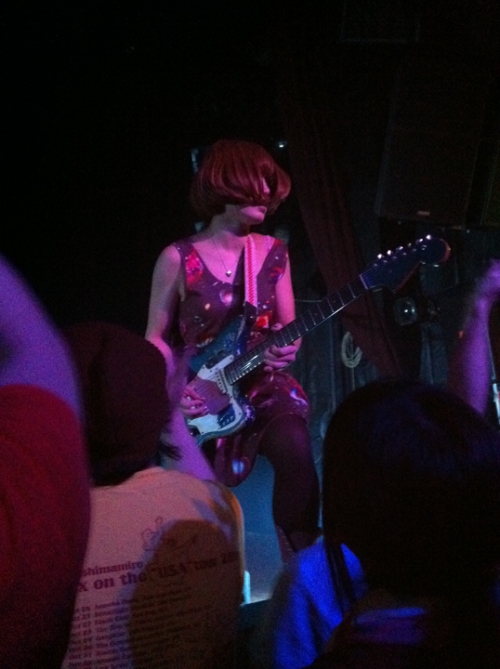



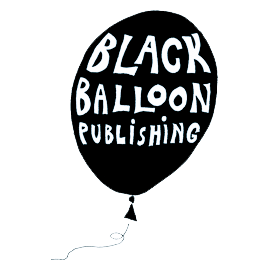 A Black Balloon Publication ©
A Black Balloon Publication ©